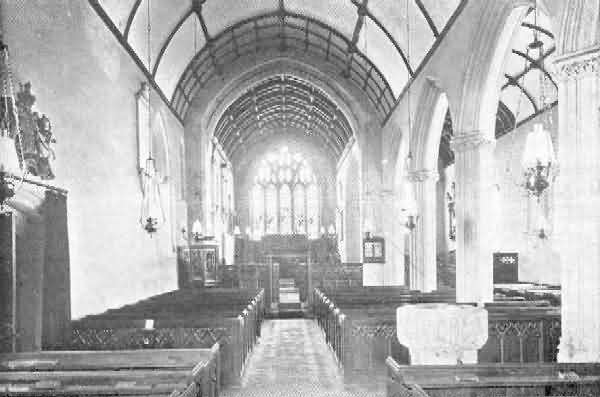
«SOME OLD DEVON CHURCHES» BY JOHN STABB; 37-48
Broadhembury [37]; Broad Hempston [38]; Brushford [39]; Buckerell [40]; Buckfastleigh [41]; Buckland-in-the-Moor [42]; Buckland Monachorum [43]; Budleigh, East [44]; Bulkworthy [45]; Burlescombe [46]; Burrington [47]; Butterleigh [48].
BROADHEMBURY. St. Andrew. The church [plate 37a] consists of chancel, nave, south aisle separated from nave by four arches, the pillars have carved capitals, south aisle chapel, north porch, and west tower with five bells; the tower is 100 feet high and is surmounted by a stunted spire The church dates from the end of the 14th, or beginning of the 15th, century. There is an old saying that the master built Broadhembury Church, and the man Broad Clyst, and that the master hung himself through mortification at being excelled in building by his man.
There are several monuments to the Drewe family in the church; they lived at a mansion called Grange in the parish. On the north wall of the chancel is a monument with the figure of a man kneeling at a desk, which is supported by an angel. He is arrayed in ruff, long robe over the shoulders, and full pantaloons; it is supposed to be in memory of Sir Thomas Drewe, but the inscription is indecipherable. There is an inscription in the chancel:— In memory of Thomas Rose, of Wootton Fitzpaine in the county of Dorset, Esq., who died the 9th of January 1747, aged 68, and was buried in the vault of this church. This was put up at the request of his only child Mary, wife of Francis Drewe Esq, of Grange in this parish, who departed this life the 7th November, 1749, aged 34, and was buried in this church.
On the south wall of the aisle chapel is a monument with the following inscription:—
To the memory of
Francis Drewe Esq who departed
this life the 24th of Decembr An. Dom
1675
and in the 71 yeare of his age.
"If floods of tears and universal love
Against the fates a Remora could prove
If virtue could the just and loyal save
From ye dishonour of ye darksome grave
Then hadst not thou most happy soul so soon
Left us in teares and to the angels gone
But walls of flesh we see can't long confine
Souls truly noble and like thine divine
Impatient of their earthly wall they still aspire
And what thou dost enjoy they most desire."
In the south aisle there are tombstones of the Drewe family, also one in memory of the Hill family of Priory, to whom there is a memorial tablet on the wall dated 1737. At the west end of the aisle there is a gallery with a stone front, and there is a wooden gallery at the west end of the nave. The tracery of the windows is very good, the window by the pulpit is said to be unique; on the mullions inside are richly carved figures of the angels, and outside, the mullions have figures said to represent the World, the Flesh, and the Devil. The Norman font [plate 37b] ranks amongst the finest half dozen in Devonshire, it is octagonal in shape, supported on square central and four corner pillars. The panels are carved with figures of saints and bishops, and there are shields for arms with the arms obliterated, if they were ever present.
Over the north door are preserved the Royal arms. The rood screen is gone and the staircase is walled up. On the south wall of the chancel is a white marble tablet with the following inscription:—
In Grateful Memory of
the Revd.
Augustus Montague Toplady, B.A.
Vicar of this parish from 1768 to 1778
and author of the immortal hymn:
"Rock of Ages cleft for me,
Let me hide myself in Thee!
Let the water and the blood,
From Thy riven side which flowed,
Be of sin the double cure
Cleanse me from its guilt and power."
to whose personal piety, brilliant gifts
sanctified learning and uncompromising advocacy
of the gospel of the Sovereign Grace of God
his writings bear abundant testimony.
This Tablet
is erected A.D. 1898, being 120 years
after he entered into the joy of his Lord
on the 11th August 1778
in 38th year of his age.
In Grateful Memory of
the Revd.
Augustus Montague Toplady, B.A.
Vicar of this parish from 1768 to 1778
and author of the immortal hymn:
"For by Grace are ye saved through faith; and
that not of yourselves; it is the gift of God,
not of works lest any man should boast."
Eph. ii. 8, 9.
The porch has a stone roof with fan tracery and old bosses. Over the entrance are three niches for statues, but these are missing. The inner doorway is well carved, and there is an image niche without the image, and the remains of a holy water stoup.
The parish registers are very complete, in unbroken succession from the year 1538, and are in a good state of preservation. There is a curious entry relating to a great frost which occurred in 1739, and lasted for nine weeks.
The first rector was Sir Martin de Litylbyri. He died in 1274.
The registers date: baptisms, 1540; marriages, 1538; burials, 1538.
BROAD HEMPSTON. St. Peter and St. Paul. The church is Perpendicular, and consists of chancel, nave, north and south aisles, south porch, and an embattled tower containing six bells, five of which were cast in the churchyard by John Christopher and William Pennington in 1781; the sixth was added in 1887 as a memorial of the Jubilee of Queen Victoria [r. 1837-1901].
The rood screen [plate 39], of oak, at one time was painted in various colours; it was restored in 1902 at a cost of £500 by Herbert Reed, when the groining was replaced. All traces of the paintings of saints on the lower panels have vanished. There are north and south parclose screens. In 1879 the chancel was thoroughly restored and re-roofed, and in 1896 £1,1000 was spent in the restoration of the nave and aisles. The tracery of the windows in the nave and the aisles is Perpendicular, the north and south windows of the chancel are said to date from the 13th century. There are three sedilia in the chancel and piscinas in the chancel and aisles. In the chancel is a tablet with arms to Robert Warreying, and Elinor his wife, 1656.
There is some old glass in the window in the west wall of the south aisle.
The date of the first vicar recorded is 1266.
The registers date: baptisms, 1681; marriages, 1678; burials, 1678.
BRUSHFORD. St. Mary. The church is very small, consisting of chancel, nave, south porch, and west tower, surmounted by a wooden spire, containing three bells.
The rood screen [plate 39] was probably erected either in the reign of Henry VIII [1509-1547] or that of Queen Mary [1553-58]. It was never intended for a rood loft, the pedestals which formerly supported the rood and figures still remain on the face of the screen over the central doorway. The lights consist of rectangular openings, with moulded shafts, the heads being filled with tracery of two kinds, the larger forming the framework, and the smaller fine fretwork filling of the same type. A great deal of the finer work has been broken away, but enough remains to show what the screen must have been like when it was perfect. It is unique among Devonshire screens, but there is said to be one very similar in Brittany, in the Church of St. Fiacre, Le Faouet.
There are several tablets to the Luxton family, by whom the church was restored in 1878.
The registers date: baptisms, 1695; marriages, 1697; burials, 1694.
BUCKERELL. St. Mary and St. Giles. The church is cruciform in shape and consists of chancel, nave, north and south transepts, and west tower. The screen [plate 40] of four bays is across the chancel arch. It retains its groining, cornice of three rows, and the lower cresting, the upper is missing. An unusual feature is the thickened central mullions which divide the fenestrations. The screen is of dark oak, the part below the bays has been very plainly restored!
The nave has a plastered wagon roof with bosses of no particular merit. There is a piscina in the chancel; a west gallery with organ, an old pulpit, and font, and the old box pews. In the north wall of the nave is a niche for a statue, but the figure is missing.
The registers date: baptisms, 1650; marriages, 1654; burials, 1653.
BUCKFASTLEIGH. Holy Trinity. The church consists of chancel, with priest's door, north and south aisles with chapels at the east end, north and south transepts, south porch, and west tower, containing six bells, surmounted by a spire rather out of the perpendicular.
The church is mainly Late Perpendicular, but the chancel is Early English. The sedilia and piscina remain in the chancel, but the carving has been scraped down and the dividing pillars of the sedilia removed. There is a piscina in the south-east chapel. The rood screen has been removed, but the lower doorway remains on the north side of the church, and there is an exterior turret for the staircase; the upper doorway has been walled up. The pulpit is carved and probably contains remains of the cornice of the rood screen. The font [plate 41] is Norman with cable moulding, and is roughly supported by the pillars which were removed from the sedilia.
In the churchyard are two curious tombs. The first is that of Richard Cabell, of Brook [Manor], who died in 1677. He was the last male member of his family, and his reputation was so bad that when he died he was buried under a heavy stone, and a sort of penthouse with iron railings built over it to prevent him coming up again. The second curious tomb is that of the Bovey family; the monument is in the form of a coffin of modern shape, resting on trestles, with the inscription carved on the side of the coffin, the whole being made of granite.
At the east end of the churchyard are the remains of an old chapel, or possibly of an earlier church.
The registers date from 1602.
BUCKLAND-IN-THE-MOOR. St. Peter. The church is built on high ground, north of the village, is Early English in style, and is situated in a pretty churchyard adjoining the grounds of Buckland Court, the seat of the Bastard family.
The building consists of chancel, nave (divided from the north aisle by three arches), north transept, and embattled western tower, with five bells cast in 1760. The east window and west door are Perpendicular. In 1907 the church was restored, and the old box pews removed. The screen has also been restored [plate 42a]. Many guide books mention a carved wooden staircase to the rood loft; how this mistake arose I do not know, as there is the usual staircase built in the north wall, and I was told there never had been a staircase in the church. The screen was in great need of restoration; it is elaborately carved, the upper portion filled with Perpendicular tracery, and the lower, divided into twenty compartments, contains figures of saints. Four panels behind the reading desk containing a representation of the Adoration of the Magi. Three panels contain the Annunciation. On the door of the screen are St. Bartholomew, St. Philip, St. Andrew, and St. James the Less. On the remaining panels only two paintings were clear enough to give any idea of the subjects, these were probably St. Matthew and St. Thomas. There are also paintings on the east side of the screen which, with those of the west side, are superior in execution to most of the paintings to be found on the Devonshire screens.
In front of the altar is buried Ralph Woodley, Lord of the Manor, in 1593. The font is Norman, having a circular basin with a narrow plain band at the top, then a band of carving, with cable moulding underneath. It stands on a large circular block of stone, that looks something like another font turned upside down [plate 42b]. The church was probably erected in the 13th century, the earliest mention is in Bishop Lacey's Register (1420).
The registers date: baptisms, 1692; marriages, 1694; and burials, 1728.
BUCKLAND MONACHORUM. St. Andrew. The church [plate 43a] consists of chancel, nave, separated from aisles by five lofty arches on each side resting on clustered pillars, north and south aisles with chapels, very shallow north and south transepts, south porch with oak roof and carved bosses, and west tower with six bells, dating from 1723. The nave roof has finely carved figures of angels playing musical instruments.
On the north side of the chancel is a small walled up arch, possibly an Easter Sepulchre or low window. The chancel roof is waggon-shape, plastered, with carved bosses at the intersections of the oak ribs. The chancel arch is curious, on the north side it rests on the capital of a low pillar, while on the south side the supporting pillar is carried upwards with a bend, and the arch rests on a capital which is on a line with the top of the eastern arch of the nave. The priest's door is in the south chapel, this chapel has a roof with granite ribs and bosses having four heads conjoined. At the east end of this chapel is the monument of George Augustus Elliot, Baron Heathfield of Gibraltar, who died July 6th 1790, aged 72 years. This monument is by [John] Bacon [1740-1799], and there is another by the same sculptor on the south wall in memory of Sir Francis Henry Drake of Buckland Abbey, who died February 17th 1794, aged 70 years; yet a third monument by Bacon is in memory of Francis Augustus Elliot, Lord Heathfield, Baron of Gibraltar, who died January 26th 1813. Built in the east wall of the south transept is half a small arch, probably the remains of a piscina, and higher up in the wall is a square hole which might have been an aumbry, but the position seems rather too high. Mr. Edmund Bishop in his «History of the Christian Altar», referring to the reservation of the Blessed Sacrament says:— "During the whole Middle Ages the usual place of reservation was in some recess, or as it were cupboard, often closed with high bars, sometimes fairly high up in the wall, on the Gospel, and more rarely on the Epistle side of the Altar." The presence of a piscina proves that there was an altar here at one time, so perhaps the recess in the wall was used for the above purpose.
At the east end of the north chapel, under an arch, are preserved the arms of Charles II [r. 1660-1685], dated 1660. At each side of the east window in the south transept, and on the south side of the east window in the north transept, there are stone brackets which at one time probably supported images. The nave and aisles retain their old carved bench-ends; these, with but one exception, are carved with geometrical designs, the exception is in the north side, and has on each of its panels a half figure holding a shield, that on the left bearing a floriated staff, and that on the right a St. Andrew's cross. The heads of the figures wear an ornament rather difficult to make out, it is either a cross or a mitre, and there appears to be angels on each side of the figures placing these ornaments on the heads of the figures.
The octagonal font [plate 43b] is of granite, the sides of the bowl have shields, one having a grotesque face with the tongue out, and another the initial "T". The belfry roof has grotesque masks for bosses at the intersections of the ribs. Across the belfry arch is a screen [plate 43c] consisting of two bays and the doors, which is said to have formed part of the screen from Sheepstor Church; the lower panels and cresting are modern, but a good vine cornice remains, and the tracery is old.
In the belfry are the Ringers' Rules as follow:—
"We ring the Quick to Church, the Dead to Grave
Good is our use, such usage let us have.
Who swears, curseth, or in a choleric mood
Quarrels and strikes, altho he draws no blood;
Who wears his hat, or spurs, or turns a bell,
Or by unskilful handling mars a peal;
Let him pay sixpence for each single crime
Souls truly noble and like thine divine
Twill make him cautious gainst another time;
Now round let's go and when we've done let's sing
God bless our Holy Church, God save the King."
Beneath this board is a tombstone with the following inscription:— Here lyeth buried the body of Joseph Rowe who was vicar of this parish sixty three years, he died on ye 3rd day of April in ye year of our Lord God 1708, ætatis suae 98.
The bells were restored and re-hung and the new clock placed in position by parishioners and friends in recognition of the completion of 50 years of faithful service as vicar of the parish of the Rev. Richard James Hayne, 1855 to 1905.
In the porch there is a short shaft and recess for a holy water stoup. The lead pipes outside the church bear date 1735. There are two curious epitaphs in the churchyard, one to a blacksmith is as follows:—"My Sledge and hammer both declined
My bellows too have lost their wind
My fires extinct my forge decayed
And in the dust my vice is laid
My coal is spent my irons gone
My nails are drove — my work is done."
The second is:—
"Farewell vain world I've seen enough of thee
And now am careless what thou sayst of me
Thy smiles I count not nor thy frowns I fear
My cares are past my head rests quiet here
What thou see'st in me take care to shun
And look at home, enough there's to be done
Whether I go or stay it matters not
To who related or by whom begot
I was, now am not, ask no more of me
It's all I am and all that thou can'st be."
The old churchyard cross at the west end of the churchyard has been restored.
The registers date: baptisms, 1552; marriages, 1540; burials, 1538.
BUDLEIGH, EAST. All Saints. The church consists of chancel, nave, north and south aisles, south porch, and embattled western tower with clock and six bells, five cast in 1755 and one added in 1875. It was probably erected between 1420 and 1425 on the site of an earlier church, and is noted for its connection with the Ralegh family, its carved bench-ends and its rood screen [plate 44a]. The latter is of the same type as those in Bow, Braunton and Calverleigh, square-headed lights with pierced spandrels. At one time there was a rood loft supported by a beam fixed above the screen. This loft must have projected two to three feet from the chancel arch; the end of the beam was found in its original position some years since when the rood staircase was opened up. The cresting of the screen is comparitively modern, and in the lower panels the oak has been replaced with deal.
The entrance to the staircase is between the pier of the chancel and of the south aisle and the first half pier of the nave, the lower and upper doorways both face the nave. There is a curious hagioscope in the staircase, this could not have been for the use of the congregation unless the door was kept open. A second hagioscope is in the south aisle, separated from the rood staircase by the width of the half pier of the nave. The position of the staircase is rather unusual, a somewhat similar example is to be found at Lydford.
The carved bench-ends are unusually rich, they date from 1537. They are square-headed and about 3 feet high, and from 16 to 17 inches broad. There are about 63 remaining, and in no two cases is the carving alike. On one there is a man's head with the mouth open, showing the teeth with something between them, whether his tongue or a substance he is supposed to be swallowing it is difficult to say; another has a griffin in a sitting position, another a head with a long beard, another an angel bearing a shield with the arms of the St. Clere family, another a ship with three masts, riding on the sea; and yet another, at the eastern end of the central aisle on the northern side, bears the arms of the Ralegh family, with the date at the bottom [plate 44b]. It is rather remarkable that there should be no religious symbol carved on any of the pews.
At the east end of the central aisle is the gravestone of the second wife of Sir Walter Ralegh's father. The inscription, through age, is difficult to read. Dr. Oliver gives it as follows:—
Orate pro aia
Johanne Raleyh uxoris Walti
Raleyh que
Obiit X Die Mens Augusti Anno Dni M C C . . . .
The first vicar mentioned is Stephen de Budleigh, admitted July 11th 1261, on the presentation of the Prioress and Convent of Polsloe.
The registers date: baptisms, 1555; marriages, 1556; burials, 1562.
BULKWORTHY. St. Michael. The church [plate 45a] consists of chancel, nave, south aisle, and bell turret with two bells. The church is said to have been built by Sir William Hankford, Chief Justice of the King's Bench 1414-22, as formerly appeared by an inscription on the window. (For Sir William Hankford see entry on Monkleigh.) The eastern part of the nave and the chancel is divided from the aisle by two arches, the western by a wall of great thickness, pierced with a curious opening like a window; from the position it does not seem likely to have been a squint. There is not much of interest in the church except the font and the pulpit. The former is circular with cable moulding, the latter [plate 45b] is carved with the emblems of the Crucifixion, St. Peter weeping, and the Cock crowing, the Angel rolling away the stone from the Sepulchre, and our Lord's Resurrection. On the pulpit is the following inscription:— In memory of William Newcome of Hankford who died December the 15th 1854, aged 59 years. In life respected, in death regretted. This pulpit was erected in affectionate remembrance by his four sons, William, Henry, James, and Octavius.
Over the porch is a parvise entered by an outside staircase.
The registers date: baptisms, 1709; marriages, 1829; burials, 1724.
BURLESCOMBE. St. Mary. The church consists of chancel, nave, north and south aisles, north porch, and west tower. There is a piscina in the chancel and another in the north aisle. On the north side of the chancel under an arch is an old altar tomb, the front ornamented with a series of richly canopied niches containing figures of ecclesiastics holding shields, on which are emblazoned alternately a fleur-de-lis and a cross. The tomb commemorates Nicholas Ayshford and his two wives, Isabella and Margaret. In the north aisle at the east end is another monument to the same family. It represents a male and a female kneeling before a prie-dieu; the man is arrayed in ruff and long cloak, and the woman in ruff, tight bodice, and full skirt; there is the following inscription:— In mortem et memoriam Rogeri Ayshford armigeri epitaphium, qui obiit quinto die Januarii Anno Domini 1610. Anno ætatis suæ 76.
"You that pass by this tomb stand still awhile
And with your tongues and tears the tyme beguile
To see soe good a man betrayed to dust
And no cause why save that he was right just.
The Church and Churchmen was his chief delight
To other things hee scarce had appetite
Or if he has twas like himself twas rare
So zealous all his recreations were
He wish't and wanted tyme, which was withstoode
Not to lyve long, but to doe more good
Wherein though death hath crost, het he'll have
His virtuous life survyve his marble grave."
On the wall of the north aisle is a third monument of the Ayshford family with this inscription:— To the memory of Elizabeth Ayshforde, wife of Arthur Ayshforde, eldest sonne of Henry Ayshforde, Esq., only daughter to the Right Honb. Lord Charles Wilmot, Viscount of Athlone, late General of His Majesty's forces in the Kingdom of Ireland, now a Privy Councellor both of England and Ireland. She dyed the 23rd year of her age, Anno Dni. 1635, June 13th.
The nave is separated from the aisles by three arches on each side supported on clustered pillars. The capitals on the north side have shields with coats of arms.
There is a rood screen [plate 46] of five bays across the chancel. It is of the Budleigh type, the lights being square-headed, the loft and coving and the original cornice work are gone, but there is a modern cornice and cresting, the doors are missing. The screen is said to have originally stood across the two piers outside the present chancel.
On the south side of the entrance gate in the churchyard is a curious Memento mori consisting of a death's head and cross-bones over a body wrapped in a shroud.
The registers date: baptisms, 1579; marriages, 1580; burials, 1579.
BURRINGTON. Holy Trinity. The church consists of chancel, nave, south aisle, south porch, and embattled tower on the north side, containing six bells.
There is nothing in the church of much interest with the exception of the screen [plate 47], but this is very fine in construction, though it is not improved by being painted sky-blue, and the carving in the spaces between the ribs of the groining picked out in gilt and colours. The groining and cornices are complete. The nine ribs to each shaft of the groining give a wide and fanlike effect. The arcades are wide and low, with the four centred heads; the tracery is of Perpendicular character, with a central mullion running into the apex, as at Swymbridge, Atherington, etc.
The church was restored in 1869, and has an open oak roof supported by solid monoliths of granite.
The registers date: baptisms, 1601; marriages, 1601; burials, 1592.
BUTTERLEIGH. St. Matthew. The church consists of chancel, nave, north aisle, divided from three arches, west tower with three bells, and south porch with corbels of the heads of a king and a queen.
The church has been restored, the original church was enlarged by Dr. Peter Muden, a Dutchman, who married one of the Courtenays; she died in 1624, and had a monument in the church.
There is a modern rood screen of four bays and a doorway. There is no groining and the lights are without tracery. There is a floriated cross and six candlesticks on the beam. There is a piscina in the chancel, and the east window has a king's and a queen's head for corbels, as in the porch. There is an old Norman font, but it has been so much scraped it is not of great interest. There is an old money box dating from 1629, with the initials "I.P." and the following inscription:—
This boxe
is frelie gi
ven to recea
ve almes for ye
poore.
The registers date from 1698.

Broadhembury: Interior
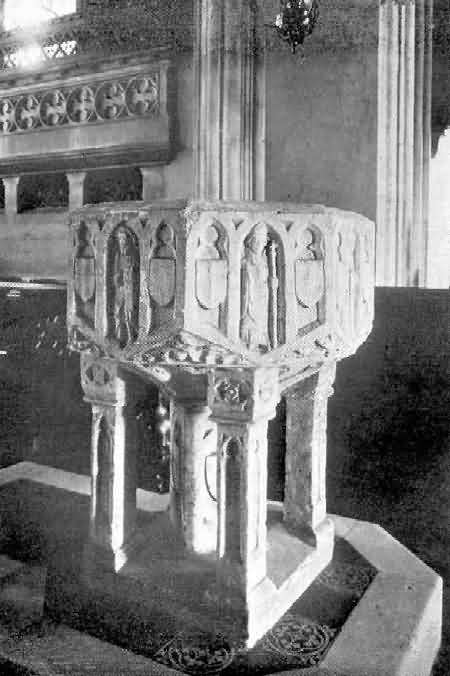
Broadhembury: Font
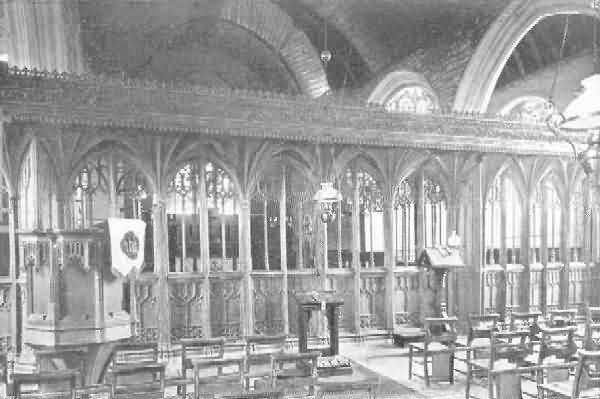
Broad Hempston: Rood Screen
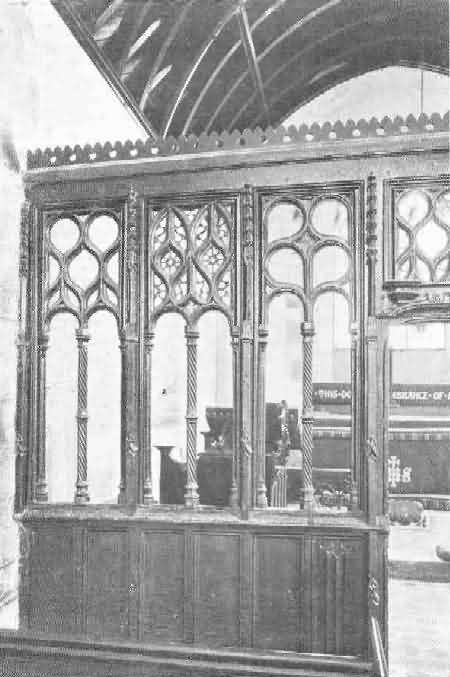
Brushford: Rood Screen
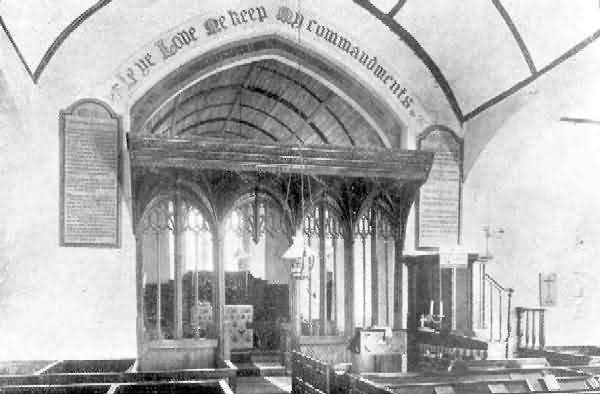
Buckerell: Rood Screen
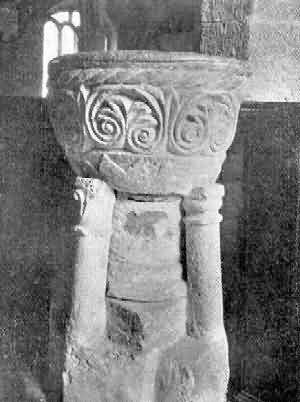
Buckfastleigh: Font
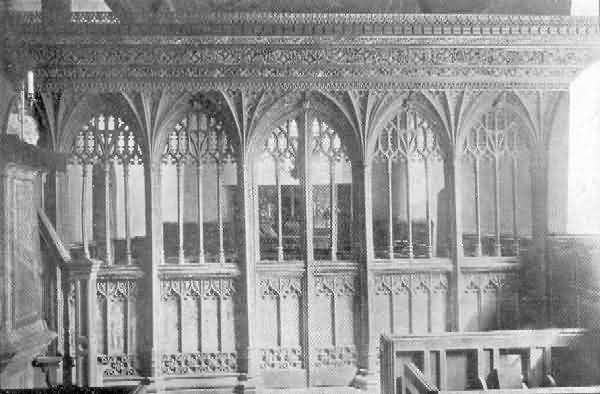
Buckland-in-the-Moor: Rood Screen
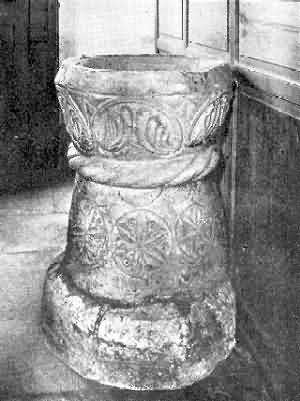
Buckland-in-the-Moor: Font
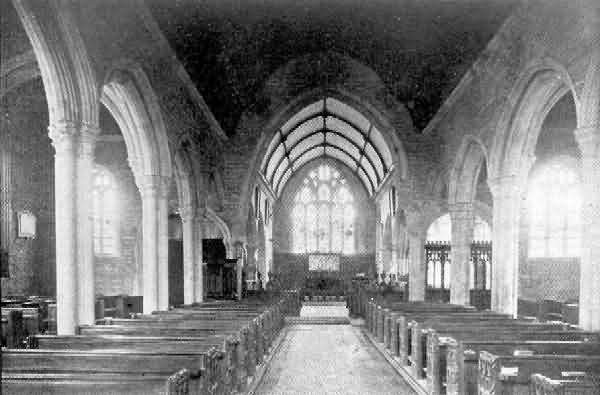
Buckland Monachorum: Interior
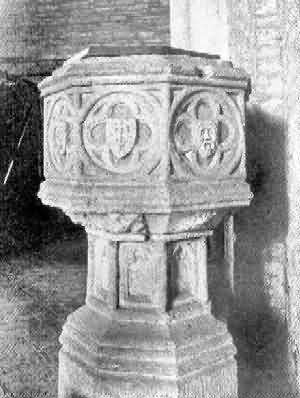
Buckland Monachorum: Font
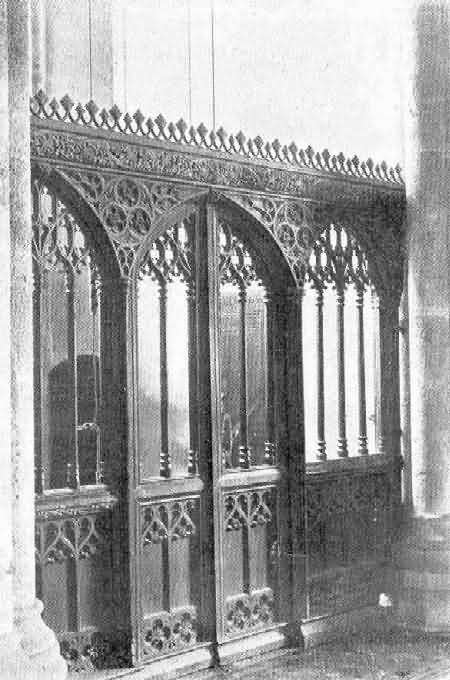
Buckland Monachorum: Belfry Screen
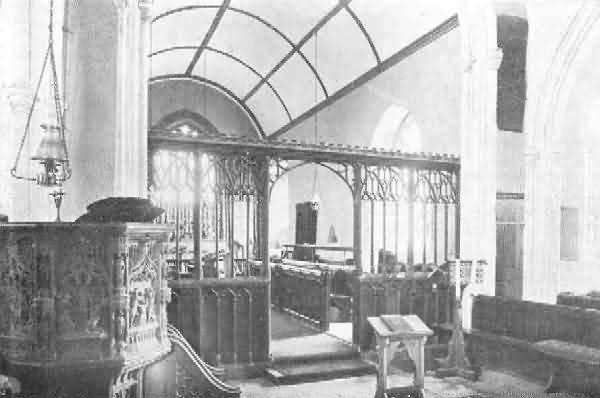
Budleigh: Rood Screen
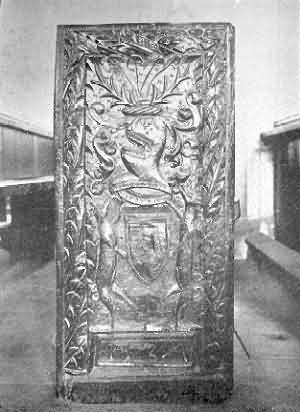
Budleigh: Ralegh Bench-End
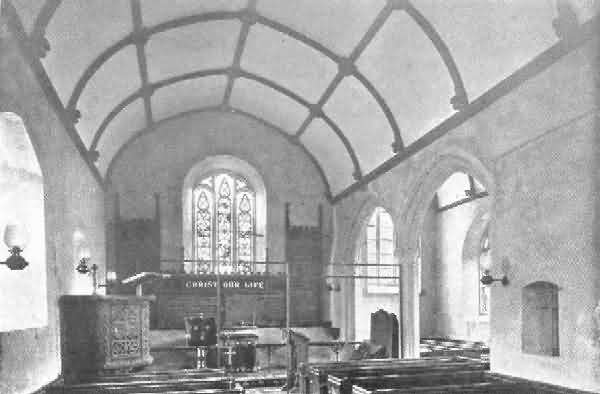
Bulkworthy: Interior
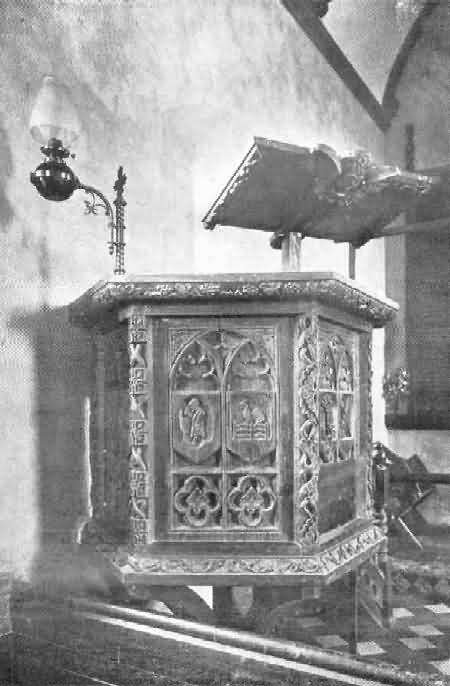
Bulkworthy: Pulpit
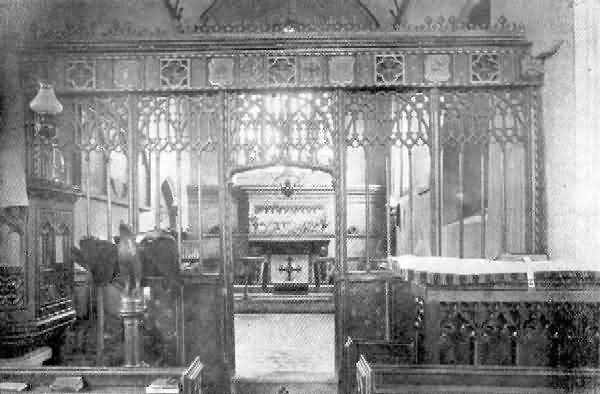
Burlescombe: Rood Screen
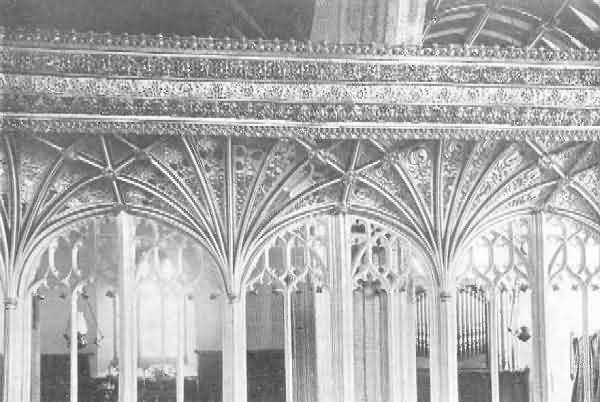
Burrington: Rood Screen
«Some Old Devon Churches»:
Index; 49-60
[Dr. R. Peters: rpeters@wissensdrang.com]